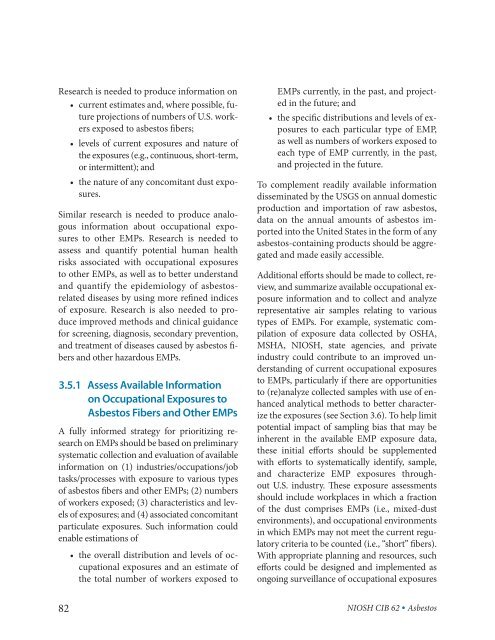Asbestos Fibers and Other Elongate Mineral Particles: State of the ...
Asbestos Fibers and Other Elongate Mineral Particles: State of the ...
Asbestos Fibers and Other Elongate Mineral Particles: State of the ...
- No tags were found...
Create successful ePaper yourself
Turn your PDF publications into a flip-book with our unique Google optimized e-Paper software.
Research is needed to produce information on<br />
• current estimates <strong>and</strong>, where possible, future<br />
projections <strong>of</strong> numbers <strong>of</strong> U.S. workers<br />
exposed to asbestos fibers;<br />
82<br />
• levels <strong>of</strong> current exposures <strong>and</strong> nature <strong>of</strong><br />
<strong>the</strong> exposures (e.g., continuous, short-term,<br />
or intermittent); <strong>and</strong><br />
• <strong>the</strong> nature <strong>of</strong> any concomitant dust exposures.<br />
Similar research is needed to produce analogous<br />
information about occupational exposures<br />
to o<strong>the</strong>r EMPs. Research is needed to<br />
assess <strong>and</strong> quantify potential human health<br />
risks associated with occupational exposures<br />
to o<strong>the</strong>r EMPs, as well as to better underst<strong>and</strong><br />
<strong>and</strong> quantify <strong>the</strong> epidemiology <strong>of</strong> asbestosrelated<br />
diseases by using more refined indices<br />
<strong>of</strong> exposure. Research is also needed to produce<br />
improved methods <strong>and</strong> clinical guidance<br />
for screening, diagnosis, secondary prevention,<br />
<strong>and</strong> treatment <strong>of</strong> diseases caused by asbestos fibers<br />
<strong>and</strong> o<strong>the</strong>r hazardous EMPs.<br />
3.5.1 Assess Available Information<br />
on Occupational Exposures to<br />
<strong>Asbestos</strong> <strong>Fibers</strong> <strong>and</strong> <strong>O<strong>the</strong>r</strong> EMPs<br />
A fully informed strategy for prioritizing research<br />
on EMPs should be based on preliminary<br />
systematic collection <strong>and</strong> evaluation <strong>of</strong> available<br />
information on (1) industries/occupations/job<br />
tasks/processes with exposure to various types<br />
<strong>of</strong> asbestos fibers <strong>and</strong> o<strong>the</strong>r EMPs; (2) numbers<br />
<strong>of</strong> workers exposed; (3) characteristics <strong>and</strong> levels<br />
<strong>of</strong> exposures; <strong>and</strong> (4) associated concomitant<br />
particulate exposures. Such information could<br />
enable estimations <strong>of</strong><br />
• <strong>the</strong> overall distribution <strong>and</strong> levels <strong>of</strong> occupational<br />
exposures <strong>and</strong> an estimate <strong>of</strong><br />
<strong>the</strong> total number <strong>of</strong> workers exposed to<br />
EMPs currently, in <strong>the</strong> past, <strong>and</strong> projected<br />
in <strong>the</strong> future; <strong>and</strong><br />
• <strong>the</strong> specific distributions <strong>and</strong> levels <strong>of</strong> exposures<br />
to each particular type <strong>of</strong> EMP,<br />
as well as numbers <strong>of</strong> workers exposed to<br />
each type <strong>of</strong> EMP currently, in <strong>the</strong> past,<br />
<strong>and</strong> projected in <strong>the</strong> future.<br />
To complement readily available information<br />
disseminated by <strong>the</strong> USGS on annual domestic<br />
production <strong>and</strong> importation <strong>of</strong> raw asbestos,<br />
data on <strong>the</strong> annual amounts <strong>of</strong> asbestos imported<br />
into <strong>the</strong> United <strong>State</strong>s in <strong>the</strong> form <strong>of</strong> any<br />
asbestos-containing products should be aggregated<br />
<strong>and</strong> made easily accessible.<br />
Additional efforts should be made to collect, review,<br />
<strong>and</strong> summarize available occupational exposure<br />
information <strong>and</strong> to collect <strong>and</strong> analyze<br />
representative air samples relating to various<br />
types <strong>of</strong> EMPs. For example, systematic compilation<br />
<strong>of</strong> exposure data collected by OSHA,<br />
MSHA, NIOSH, state agencies, <strong>and</strong> private<br />
industry could contribute to an improved underst<strong>and</strong>ing<br />
<strong>of</strong> current occupational exposures<br />
to EMPs, particularly if <strong>the</strong>re are opportunities<br />
to (re)analyze collected samples with use <strong>of</strong> enhanced<br />
analytical methods to better characterize<br />
<strong>the</strong> exposures (see Section 3.6). To help limit<br />
potential impact <strong>of</strong> sampling bias that may be<br />
inherent in <strong>the</strong> available EMP exposure data,<br />
<strong>the</strong>se initial efforts should be supplemented<br />
with efforts to systematically identify, sample,<br />
<strong>and</strong> characterize EMP exposures throughout<br />
U.S. industry. These exposure assessments<br />
should include workplaces in which a fraction<br />
<strong>of</strong> <strong>the</strong> dust comprises EMPs (i.e., mixed-dust<br />
environments), <strong>and</strong> occupational environments<br />
in which EMPs may not meet <strong>the</strong> current regulatory<br />
criteria to be counted (i.e., “short” fibers).<br />
With appropriate planning <strong>and</strong> resources, such<br />
efforts could be designed <strong>and</strong> implemented as<br />
ongoing surveillance <strong>of</strong> occupational exposures<br />
NIOSH CIB 62 • <strong>Asbestos</strong>

















